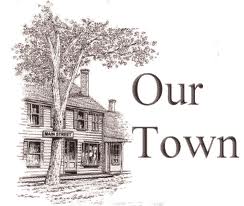
Wilder depicts the cycle by having two young citizens of Grovers Corners spontaneously disclose their love for each other.

Thus, love and marriage, a natural phenomenon which perpetuates the human race, dominate the second act. This special edition includes an afterword by Wilder's nephew, Tappan Wilder, with illuminating documentary material about the playwright and his most famous drama. Act II presents the second cycle of daily life in a town. Widely considered one of the greatest American plays of all time, Our Town debuted on Broadway in 1938 and continues to be performed daily on stages around the world. When Emily loses her life during childbirth, the circle of life portrayed in each of the three acts-childhood, adulthood, and death-is fully realized. The same year, the author debuted his first novel The Cabala, which was followed by his first Pulitzer Winning publication The Bridge of San Luis Rey in 1927. Our Town by Thornton Wilder Our Town was first produced and published in 1938 to wide acclaim. Our Town explores the relationship between two young neighbors, George Gibbs and Emily Webb, whose childhood friendship blossoms into romance, and then culminates in marriage. Nearly every character in the play loves Grovers Corners, even as many of them acknowledge its small-mindedness and dullness.

Thornton Wilder’s Pulitzer Prize-winning drama of life in the mythical village of Grover’s Corners, New Hampshire-an allegorical representation of all life-is an American classic. It is the simple story of a love affair that asks timeless questions about the meaning of love, life, and death. Our Town by Thornton Wilder Buy Study Guide Our Town Themes Small Town Life Our Town is clearly a representation - and largely a celebration - of small-town American life. “ leaves us with a sense of blessing, and the unspoken but palpable command to achieve gratitude in what remains of our days on earth.” - The New Yorker


 0 kommentar(er)
0 kommentar(er)
